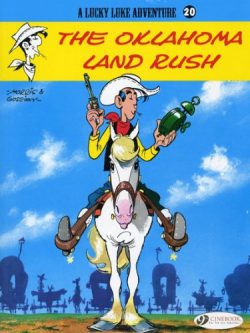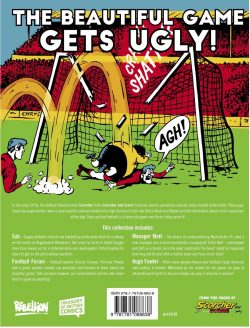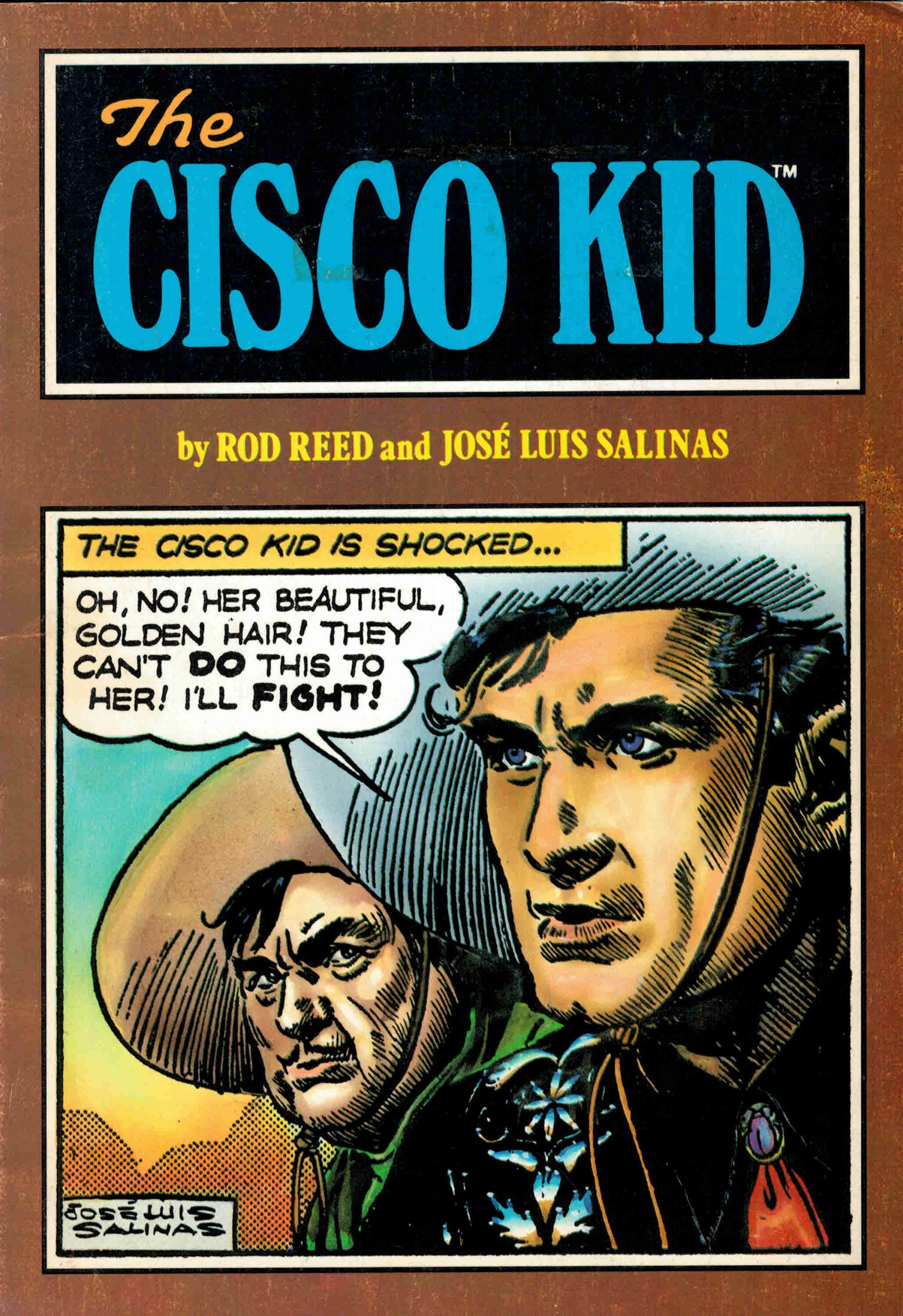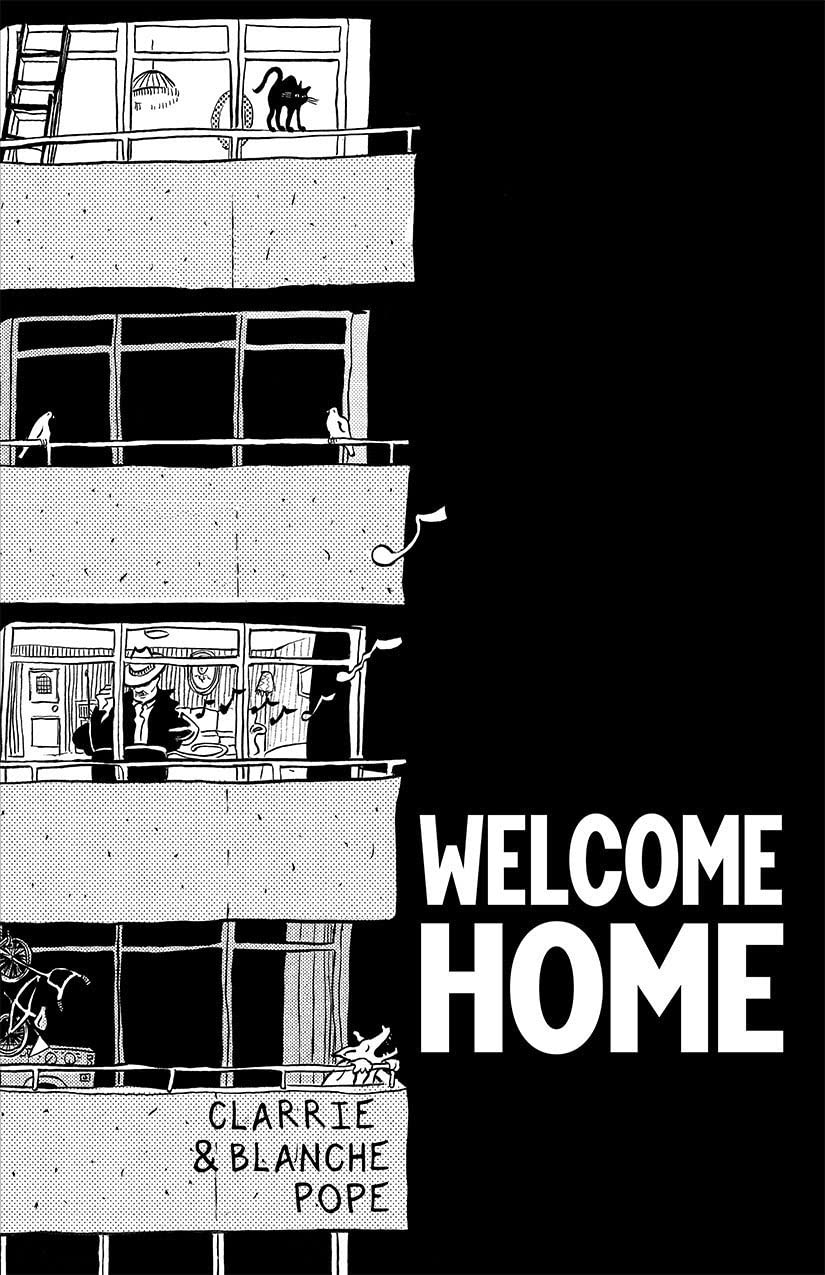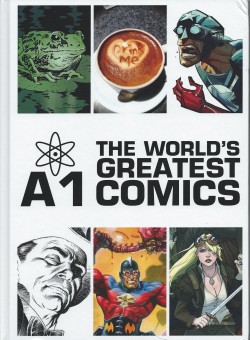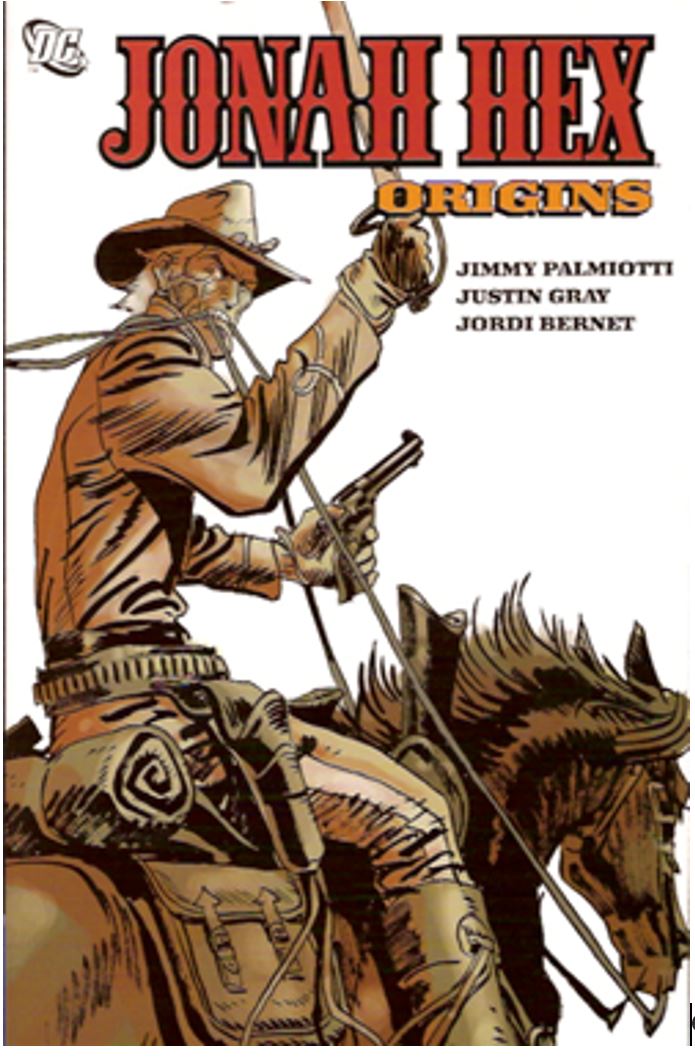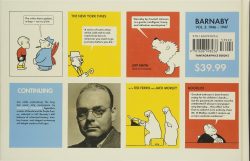
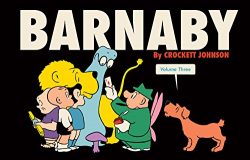
By Crockett Johnson with Ted Ferro & Jack Morley (Fantagraphics Books)Â
ISBN: 978-1-60699-823-6 (HB/Digital editions)Â
This is one of those rare books worthy of two reviews. So, if you’re in a hurry…Â
Buy Barnaby volume 3 – and all the rest – right now. It’s one of the five best newspaper comic strips of all time and this lavish hardcover/digital compilation has lots of fascinating extras. If you harbour any yearnings for the lost joys of childish wonder and the suspicious glee in catching out adults trying to pull a fast one, you would be crazy to miss this book…Â
However, if you’re still here and need a little more time to decide…Â
The once-huge range and breadth of newspaper strips – continuity drama, adventure strips or informational/sports inspired – has all but faded away as the 21st century proceeds. Cartoon strips aren’t a dying art form though: merely moved on to less valuable property in cyber-space. Check out the magnificent and resurgent return of Berke Breathed’s Bloom County – as released whenever he wants on Facebook… Â
Back in the tangible world of typesetting, if a paper actually still runs any strips – as opposed to editorial cartoons – chances are they will be of the episodic variety typified by reprints of Charles Shultz’s Peanuts or the latest hot movie/media spin-off rather than series like Doonesbury or Prince Valiant which demand a little conspicuous consistency and regular attendance from the readership. Â
You can describe the most popular strips such as Garfield or Hagar the Horrible as single-idea pieces with a set-up, delivery and punch-line, all rendered in a sparse, pared-down-to-basics drawing style. In that they’re nothing new and there’s nothing wrong any of that ilk on their own terms.Â
Narrative impetus comes from the unchanging characters themselves, and a building of gag-upon-gag in extended themes. The advantage to the newspaper was always obvious. If you like a strip it encourages you to buy the paper. If you miss a day or two, you can return fresh at any time having, in real terms, missed nothing.Â
Such was not always the case. Once upon a time the daily “funny†– comedic or otherwise – was a crucial circulation preserver and builder, with lush, lavish and magnificently rendered fantasies or romances rubbing shoulders with thrilling, moody masterpieces of crime, war, sci-fi and everyday melodrama, and the always-unmissable delights of legion of humour strips which maintained and sustained an avid, devoted following.Â
And eventually came Barnaby, which in many ways bridged the gap between then and now.Â
On April 20th 1942, with America at war for the second time in 25 years, liberal New York tabloid PM began running a kids’ strip which was simultaneously the most whimsically addicting, socially seditious and ferociously smart satire since Al Capp’s Li’l Abner – another utter innocent left to the mercy of scurrilous worldly influences.Â
Crockett Johnson’s outlandish 4-panel daily was the product of a perfectionist who didn’t particularly care for comics, but who – according to celebrated strip historian Ron Goulart – just wanted steady employment…Â
David Johnson Leisk (October 20th 1906-July 11th 1975) was an ardent socialist, passionate anti-fascist, gifted artisan and brilliant designer who had spent much of his working life as a commercial artist, Editor and Art Director. Born in New York City and raised in the outer wilds of Queens when it was still semi-rural (in Flushing Meadows near the slag heaps which would eventually house two New York World’s Fairs), “Dave†studied art at Cooper Union (for the Advancement of Science and Art) and New York University before leaving early to support his widowed mother. Â
This entailed embarking upon a hand-to-mouth career drawing and constructing department-store advertising. He supplemented his income with occasional cartoons to magazines like Collier’s before becoming an Art Editor for magazine publisher McGraw-Hill. He also started a moderately successful, “silent†strip called The Little Man with the Eyes.Â
Johnson divorced his first wife in 1939 and moved out of the city to Connecticut, to share an ocean-side home with student (and eventual bride) Ruth Krauss. Ceaselessly looking to create that steady something, almost by accident he devised a masterpiece of comics narrative…Â
However, if friend Charles Martin hadn’t seen a prototype Barnaby half-page lying around the house, it might never have existed. Thankfully, Martin hijacked the sample, parlaying it into a regular feature in prestigious highbrow leftist PM simply by showing the scrap to the paper’s Comics Editor Hannah Baker. Among her other notable finds was a strip by Theodor (“Dr.â€) Seuss Geisel which would run contiguously in the same periodical. Despite Johnson’s initial reticence, within a year Barnaby was the new darling of the intelligentsia…Â
Soon came book collections, talk of a Radio show (in 1946 it was adapted as a stage play), a quarterly magazine and rave reviews in Time, Newsweek and Life. A small but rabid fan-base ranged from politicians and smart set paragons like President and First Lady Roosevelt, Vice-President Henry Wallace, Rockwell Kent, William Rose Benet and Lois Untermeyer to ultra-cool celebrities such as Duke Ellington, Dorothy Parker, W. C. Fields and legendary New York Mayor Fiorello La Guardia. Of course, the last two might only have checking the paper because the undisputed, unsavoury star of the strip was a scurrilous if fanciful amalgam of them both…Â
Not since George Herriman’s Krazy Kat had popular culture so infiltrated the halls of the mighty, whilst largely passing way over the heads of the masses or without troubling the Funnies sections of mass-circulation papers. Over its 10-year run (April 1942 to February 1952), Barnaby was only syndicated to 64 papers nationally – a combined circulation of just over five and a half million – but it kept Crockett (a childhood nickname) and Ruth in relative comfort whilst America’s Great & Good constantly agitated on the kid’s behalf.Â
What more do you need to know? Â
One dark night, during an air raid drill, a little boy wished for a Fairy Godmother and something strange and disreputable fell in through his window…Â
Barnaby Baxter is a smart, ingenuous and scrupulously honest pre-schooler and his ardent wish was to be an Air Raid Warden like his dad. Instead he was “adopted†by a short, portly, pompous, distinctly unsavoury and wholly discreditable windbag with pink pixie wings.Â
Installing himself as the lad’s “Fairy Godfatherâ€, Jackeen J. O’Malley was a card carrying-member of the Elves, Gnomes, Leprechauns and Little Men’s Chowder and Marching Society – although he hadn’t paid dues in years. A lazier, more self-aggrandizing, mooching old glutton and probable soak could not be found anywhere. To be fair, although he certainly frequented taverns, he only ever raided the Baxter’s icebox, pantry and humidor, never their drinks cabinet… Â
Due more to intransigence than evidence – there’s always plenty of physical proof, debris and fallout whenever O’Malley has been around – Barnaby’s parents adamantly refuse to believe in an ungainly, insalubrious sprite, whose continued presence hopelessly complicates the sweet boy’s life. Their abiding fear is that Barnaby was cursed with Too Much Imagination…Â
In earlier episodes, O’Malley became implausibly – and almost overnight – an unseen and reclusive public Man of the Hour, preposterously translating that dubious cachet into a political career by accidentally becoming a patsy for a corrupt political machine. In even more unlikely circumstances O’Malley was elected to Congress…Â
This strand gave staunchly socialist cynic Johnson ample opportunity to lampoon the electoral system, pundits and public. As usual, Barnaby’s folks perpetually overruled their boy: assertively assuring him the O’Malley grown-ups had elected was not a little man with pink wings…Â
Despite looking like a fraud – he’s almost never seen using his magic and always has one of Dad’s stolen panatela cigars as a substitute wand – J. J. O’Malley is the real deal: he’s just incredibly lazy, greedy, arrogant and inept. He does – sort of – grant Barnaby’s wishes… but never in ways that might be anticipated…Â
Once O’Malley got his foot in the door – or through the bedroom window – a succession of bizarre characters also turned up to baffle and bewilder poor Barnaby and Jane Shultz, the sensible little girl next door who was also privileged to perceive the pompous pixie. Â
Even Barnaby’s new dog Gorgon was an oddity. The pooch could talk – but never when adults were around, and only with such staggering dullness that everyone listening wished him as mute as other mutts. More mythical oddballs and irregulars included timid ghost Gus; Atlas the Giant (a 2-foot tall, pint-sized colossus unimpressive until he got out his slide-rule to demonstrate that he was, in fact, a Mental Giant); Gridley the Salamander (a “Fire Pixey†who couldn’t raise a spark even if supplied with matches and gasoline); water hating sea god Davey Jones and puny Puritan pixie Cousin Myles O’Malley. Â
The greatest of these wry creations was Launcelot McSnoyd: invisible Leprechaun and O’Malley’s personal gadfly, persistently proffering harsh, ribald counterpoints and home truths to the Godfather’s self-laudatory pronouncements…Â
Johnson continually expanded his bizarre cast of gremlins, ogres, ghosts, policemen, bankers, crooks, financiers and stranger personages – all of whom could see O’Malley – while the unyieldingly faithful lad’s parents were always too busy and obdurately certain the Fairy and all his ilk were unhealthy, unwanted, juvenile fabrications.Â
The officious elf’s schemes grew evermore fanciful. He was a boxing impresario, attempted to have constructed two utterly unnecessary hydroelectric dams, wrote the definitive text on Pixie Anthropology and usurped running the factory managed by Barnaby’s father. After that O’Malley campaigned in the then-ongoing Presidential Election, tried crime-busting and even took a turn as a most improbable Wall Street wizard and publishing mogul. Â
This third tipsy-turvy treasury opens with hearty appreciation from award-winning cartoonist Jeff Smith in the Foreword before Nathalie op de Beeck’s ‘Notes on a Haunted Childhood’ details the relationship of the author to his signature character, after which the whimsical wonderment resumes with the strips spanning January 1st 1946 to December 31st 1947. The serialised silliness opens with a delicious and delirious assault on the growing phenomenon of radio quiz shows as ‘Our Next Contestant, Mr. O’Malley’ (January 2nd -February 2nd). Seeking finance for making his prospective movie masterpiece the overconfident oaf inveigles his way onto the “Detect and Collect Show†but things don’t go quite his way…Â
His overall scheme remains becoming ‘J. Darryl O’Malley, Movie Mogul’ (February 4th – March 16th) but when a suitable text for his magnum opus cannot be found he opts to pen his own bestselling book first. However, since he’s such a busy magnate, he eventually gets Gus to ghost-write for him while he secures stars. A simple phone call to Hollywood creates a storm of chaos in the glitzy land where Dreams Come True, scripts are judged by weight and page count and a confidant lie is the ultimate weapon…Â
As sparks fly in Hollywood, the elf has already moved on. Taking umbrage at the senior Baxter’s perpetual rubbishing of his very existence ‘Professor O’Malley’ (March 16th – April 4th) seeks to prove his bona fides through atomic age Science and arranges a lecture on mythological folk, inviting Gridley, McSnoyd, Atlas, Gus and more. Tragically, a mix-up in scheduling venues soon scuppers the plan…Â
As a result of the confusion, the Baxter and Schultz pantries and iceboxes took particularly significant hits and the astounded, anxious parents call in the police to track down ‘The Refrigerator Bandit’ (April 5th – May 11th). Filled with civic outrage, O’Malley joins the hunt, even organising a unique posse of his comrades, but somehow that only leads to greater atrocities on already abused larders… and now extends to cigar humidors… Â
Midsummer madness is sparked when Mr. Baxter is cajoled into joining the office baseball team and the ever-helpful Fairy Godfather decides to offer the benefits of his vast coaching experience in ‘O’Malley at the Bat’ (May 13th – June 22nd). Although dad is unaware, the pixey and his team are in there, pitching for him…Â
When Gorgon begins feeling enclosed and claustrophobic, hungry for a place of his own, the sensible suggestion of a dog house rapidly escalates into another major human headache and the absolutely unnecessary solution of ‘The J. J. O’Malley Housing Project’ (June 24th – August 24th). At a time when America faced an accommodation crisis, the Pixie’s posturing and proposal of “the Baxter Plan†soon triggers a land rush and city scandal with a totally bewildered Pa Baxter suddenly seconded to the City School Board. What a surprise then, when the always unseen winged wonder decides to open ‘The O’Malley School’ (August 26th – November 2nd) and radically reform the way teaching works…Â
If you’re of an historical mien, during this strip, Johnson’s assistants Ted Ferro and Jack Morley began signing strips even as the teaching tale migrated into a canny poke at progressive methodology and bean-counting civic administrators seeking to save cash and instigate cut-rate education…Â
Trend-based commerce and rampant consumerism fell under the satirical spotlight next as, in the last days of post-war shortages and rationing, Mr. Baxter applied for a new car. His chances seem slim but O’Malley has a plan – involving raffle tickets – and soon ‘The New Packomobile’ (November 4th – December 14th) arrives, albeit as the result of skulduggery, subterfuge and venal opportunism on the part of an automobile manufacturer. Of course, it doesn’t actually reach the perplexed parent the way any human intended… Â
With Christmas bearing down on everyone, a discussion of seasonal demands on limited finances neatly segues – via a chemistry set gift – into an exploration of ‘The Atomic Age’ (December 16th 1946 – March 1st 1947). It’s triggered by the Pixie noticing a marked lack of that most modern element Uranium in the toy box. His subsequent search almost creates as much carnage and catastrophe as an actual thermonuclear detonation, particularly after he finds a mallet perfect for splitting atoms….Â
Th mayhem magnifies when – despite all the Fairy Godfather’s efforts to avoid him – his disreputable reprobate “black sheep†brother ‘Orville O’Malley’ (March 3rd – May 24th) hits town and pays a visit. He seems very interested in stock market investments and the family finances…Â
‘Top Dog’ (May 26th – June 28th) then focusses on Gorgon’s aspirations as the mouthy mutt refuses to enter a local kids’ pet show after which the absentee O’Malley returns just in time for the Baxter’s annual seaside excursion, and a brush with nervous teen lovers Bob and Angelica who need the assistance of an unseen coach to confirm their passion. Happily there’s ‘The Mysterious Troubadour’ (June 30th – August 23rd) and his bizarre backing band of spooks, fairies and kibitzers. Romantic melodies carry, however, and soon the Godfather is engaged himself…  Â
On the group’s return the chastened, still single sprite delves into domesticity, remodelling the Baxter abode and descending inevitably to the disaster via ‘Mr. O’Malley’s Book of Household Management’ (August 25th – September 13th) before being drawn back onto the world stage as humans pollute the sacred dell that is the nation home of all the assorted creatures of fancy and provoking a declaration of war against mankind…Â
Lacking a sense of reason or proportion the inexorable march to conflict is exacerbated by the little Peoples’ quest for ‘Sylvania’s Secret Weapon’ (September 15th – December 23rd) as the year closes, storm clouds gather and talks cease. It’s a cliffhanging pause to ponder as ‘Sylvania Vs The United Nations’ (December 24th – 31st) barely begins before the comics time runs out. Don’t fret though: everything will continue and conclude in the next book… Â
More elucidatory content follows in education scholar and Professor of English Philip Nel’s fact-filled, scene-setting, picture-packed Afterword essay ‘Escape Artist?’ which explores how and why Johnson turned the feature over to Ferro and Morley whilst deconstructing the series included is Coulton Waugh’s contemporary treatise ‘In Every Sense a Major Creation’ excerpted from The Comics (1947) before Nel returns with strip commentary, context and background in ‘The Elves, Leprechauns, Gnomes, and Little Men’s Chowder & Marching Society: a Handy Pocket Guide’…Â
Intellectually raucous, riotous, sublimely surreal and adorably absurd, the razor-sharp whimsy of the strip is instantly captivating, and the laconic charm of its writing is irresistible, but the lasting legacy of this ground-breaking strip is the sparse line-work that reduces images to near-technical drawings, unwavering line-weights and solid swathes of black that define space and depth by practically eliminating it, without ever obscuring the fluid warmth and humanity of the characters. Almost every modern strip cartoon follows the principles laid down here by a man who purportedly disliked the medium…Â
The major difference between then and now should also be noted, however. Johnson despised doing shoddy work, or short-changing his audience. His strips – always self-contained – built on the previous episode without needing to re-reference it, and contained three to four times as much text as its contemporaries. It’s a sign of the author’s ability that the extra wordage was never unnecessary, and uniquely readable, blending storybook clarity, the snappy pace of “Screwball†comedy films and the contemporary rhythms and idiom of authors like Damon Runyan or Dashiel Hammett.Â
Johnson managed this miracle by type-setting the dialogue and pasting up the strips himself – primarily in Futura Medium Italic but with effective forays into other fonts for dramatic or comedic effect. No educational vigilante could claim Barnaby harmed children’s reading abilities by confusing the tykes with non-standard letter-forms (a charge levelled at comics as late as the turn of this century), and the device also allowed him to maintain an easy, elegant, effective balance of black and white rendering the deliciously diagrammatic art light, airy, fresh and accessible.Â
During 1946-1947, Johnson surrendered the strip to pursue a career illustrating children’s book such as Constance J. Foster’s This Rich World: The Story of Money, but eventually he returned, crafting more magic before permanently retiring Barnaby in 1952 to concentrate on his books. When Ruth graduated she became a successful children’s writer and they collaborated on four tomes, The Carrot Seed (1945), How to Make an Earthquake, Is This You? and The Happy Egg. Â
These days Johnson is best known for his seven Harold books which began in 1955 with Harold and the Purple Crayon.Â
During a global conflagration and the ideological Cold War that followed, with heroes and villains aplenty, where no comic page could top the daily headlines for thrills, drama and heartbreak, Barnaby was an absolute panacea to the horrors without ever ignoring or escaping them. The entire glorious confection that is Barnaby is all about our relationship with imagination. This is not a strip about childhood fantasy. The theme here, beloved by both parents and children alike, is that grown-ups don’t listen to kids enough, and that they certainly don’t know everything.Â
For far too long Barnaby was a lost masterpiece. It is influential, ground-breaking and a shining classic of the form. You are all the poorer for not knowing it, and should move mountains to change that situation. I’m not kidding.Â
Liberally illustrated throughout with sketches, roughs, photos and advertising materials as well as Credits, Thank Yous and more, this big hardback book of joy is a welcome addition to 21st century bookshelves – most especially yours…Â
Barnaby volume 3 and all Barnaby images © 2016 the Estate of Ruth Krauss. The Foreword is © 2016 Jeff Smith. “Notes on a Haunted Childhood†© 2016 Nathalie op de Beeck. The Afterword and Handy Pocket Guide are © 2016 Philip Nel

